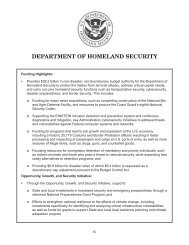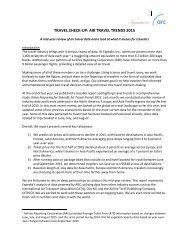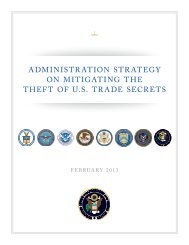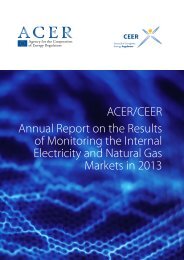A-HRC-13-42
Create successful ePaper yourself
Turn your PDF publications into a flip-book with our unique Google optimized e-Paper software.
A/<strong>HRC</strong>/<strong>13</strong>/<strong>42</strong><br />
page 34<br />
Oromo Liberation Front were allegedly held in, inter alia, 23 secret detention centres in Deder<br />
district. 100 The existence of secret detention centres in Deder district was denied by the<br />
authorities. 101<br />
73. In South Africa, during states of emergency in the 1980s, at least 40,000 people were<br />
detained, many of them charged with representing a danger to public peace. 102 Under the Internal<br />
Security Act, administrative detention in some instances effectively amounted to secret<br />
detention. In most cases, no one was allowed access to the detainee or to information about him<br />
or her, and the name of the detainee could only be disclosed by the Minister for Law and Order<br />
or a person authorized by him. 103<br />
74. In the Sudan, the use of secret detention facilities, or “ghost houses”, has for years been the<br />
subject of attention of both the United Nations human rights bodies and civil society. 104 These<br />
were used mainly in the northern part of the country, but also in Darfur and Khartoum. 105 One of<br />
the most notorious and well-known secret detention centres was the “City Bank” or al-Waha<br />
(“the Oasis”). 106 The common pattern of detentions consisted of security officers arresting<br />
individuals on suspicion of opposition activities, blindfolding them on the way to the detention<br />
centres, and then subjecting them to severe torture for periods ranging from a few weeks to<br />
several months, completely cutting them off from the outside world. 107 Amnesty International<br />
100 Report of the Special Rapporteur on torture (E/CN.4/1997/7/Add.1), para 156. See also the<br />
report of the Special Rapporteur on extrajudicial, summary or arbitrary executions<br />
(E/CN.4/1998/68/Add.1), para. 165.<br />
101 E/CN.4/1998/68/Add.1, para 168. See also the report of the Special Rapporteur on torture,<br />
summary of cases transmitted to the Governments and replies received (E/CN.4/1998/38/Add.1),<br />
para. <strong>13</strong>3.<br />
102<br />
D. Webster and F. Friedman, “Repression and the State of Emergency, June 87-March 89”,<br />
South African Review, vol. 21, 1989.<br />
103<br />
Internal Security Act, section 50A (3). See also, J. Sarkin, “Chapter XII - South Africa”, in<br />
Preventive detention and security law: a comparative survey, ed. by Andrew Harding and John<br />
Hatchard, Dordrecht; Boston [etc.]: M. Nijhoff, cop. 1993.<br />
104 See, inter alia, the report of the Special Rapporteur on torture (E/CN.4/1995/34), the joint<br />
statement submitted to the Subcommission on Prevention of Discrimination and Protection of<br />
Minorities (E/CN.4/Sub.2/1994/NGO/22), para. 7, and the report of the Special Rapporteur on<br />
torture (E/CN.4/1993/26), para. 417.<br />
105<br />
Working Group on Arbitrary Detention (E/CN.4/1994/27).<br />
106 Report of the Special Rapporteur on torture (E/CN.4/1997/7), para. 185.<br />
107<br />
Report of the Special Rapporteur on the Sudan (E/CN.4/1994/48).
















